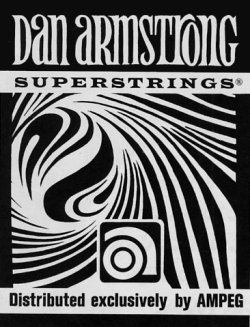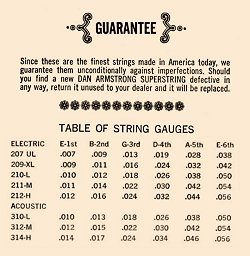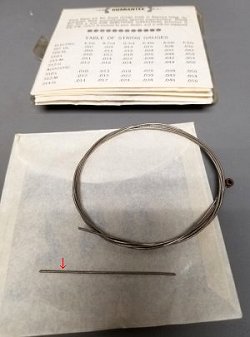

|
Dan Armstrong also produced his own custom sets of guitar & bass strings called Dan Armstrong Superstrings.
Like the advertizement seen at left, virtually every piece of literature sports the 'Distributed Exclusively By Ampeg'
slogan, along with the Ampeg 'a' logo which would seem to portray Dan as producing these string sets during the years
he was with Ampeg. But nothing could be further from the truth.
Long before his dealings with Ampeg, Dan had been providing much of his cliental with custom select sets of strings
obtained in a day and an age when such things were fairly uncommon.
|
Dan once said to me "I had some guitars in the shop strung up with some really light gauges that I kinda
threw together and everyone absolutely loved playing them when they came in. It seemed like people were playing
on them all the time, mostly because they could finally do some string bending. At the time there really wasn't
any extra light sets available on the market - yet I wanted my customers to enjoy the benefits of lighter gauge strings
so I decided to create my own custom set."
To make this custom set Dan would aquire strings from Milton Wolfe, in Chicago, then he would throw away
the low E string and shift all the remaining strings up one - then he added a high A banjo string. Together, this made
for a nice slinky set of strings his customers loved. By the time Dan had signed on with Ampeg he figured that they
would have a much broader distribution base than his own, and given how many of his customers raved about his custom
sets, Dan felt it was a profitable venture. At about the same time, Dan discovered that Milton Wolfe stings were
actually made by E&O Mari - makers of La-Bella strings.
So Dan just contracted them to make Dan Armstrong Superstrings for him as well. In this way he no longer had to throw
away any strings, as he could specify the gauges that he wanted.
As seen upper left in blue is the electric guitar set. Advertizing brochures show a total of six packaged
sets that were available. UL-207, XL-209, LL-210, L-211, M-212, & H-213 ranging in price from $3.00 to $4.00 a set.
According to Dan "this got moved down to five packaged sets as the H-213 set was removed from the lineup."
In addition, the sets now sported new names where the numbers now preceeded the gauge letters. After the changes the
strings would become known as the 207-UL, 209-XL, 210-L, 211-M, & 212-H. The selling price had also changed as it was
moved up to $4.50.
Seen above middle in yellow is the electric bass set 90-L, a light gauge set. The bass strings are the only sets that
did not see a name change, for the 1969 literature already listed them with the numbers preceeding the letters. The
Amber colored package seen at upper right is also a bass set, though a medium gauge set number 90MX. The scale length
on these strings is longer however 34½" vs. the 30½" used on the short scale version
and provides the extra length needed for long scale basses &/or basses with scroll type headstocks.
Literature dated on June 30th 1969 shows six packaged sets of bass strings that were available. 90-L, 90-M,
and 90-H were all regular scale length strings available in light, medium and heavy gauges. The remaining three sets,
the 90-LX, 90-MX, and 90-HX were the extra length scale strings (represented by the letter X) and again available in light,
medium, and heavy gauges (represented by the letters L - M & H). All bass strings were priced at $15.00 in 1969.
The acoustic guitar strings came in light, medium and heavy gauge sets as well. Literature lists them as the L-310,
the M-312 and the H-314 respectively. Like the blue packaged electric guitar strings these string sets would get
renamed as well. Whereas Dan's original acoustic string set names had the gauge letters preceding the numbers, the
name change would reverse this trend and so the acoustic string sets were now called the 310-L, the 312-M and the
314-H.
The acoustic strings came in a green color package. As seen above left, a 312-M medium gauge set sold in 1969
for $3.00 as per literature. However, by 1970 the same package had taken on a new look as well as a new price. This
was likely due not only to inflation, but to the fact that Dan had brought Ampeg in with him. Although Ampeg's
advertizing and marketing departments could reach the masses far more easily than Dan could ever hope to, the overhead
was higher as a result. As can be seen at upper middle - notice the newer look of the packaging,
and in particular the bottom of the package, which features larger lettering, as well as a price change as the sets
now sold for $3.50. At upper right, notice the various Ampeg markings on the back cover of the packaging.

|
As left, and seen better in the enlarged view, the back side of the Dan Armstrong string packages have information depicting the
individual string gauges of the various sets of Dan Armstrong Superstrings.
|
Later, Dan marketed a set that he called 'New Strings'. It is unknown exactly when these were produced but it's likely that it was in the
1980s judging by the packaging. In fact, I had never seen, nor heard of these until Patrick O'Sullivan brought them to my
attention. Seen above is the FX set. Photos are courtesy of Patrick O'Sullivan.
At left, Laurent Steen of France was looking for a piece of a wound string from a set of Dan Armstrong Superstrings to have it analyzed under a
microscope at the CNRS (The French National Centre for Scientific Research) de bordeaux in France. Laurent stated "I have a friend who is an
engineer that will test it. This will allow us to know more about the alloy used. It will give us more precision on the strings."

|
This all seemed fascinating to me so I told him I have a set of Dan Armstrong Superstrings and that I could snip off a two-inch piece of the
low E string for analysis. At left, and below the wound up E string is that two-inch piece, marked with a red arrow that I sent to him to be
analyzed. According to the string set packaging, the low E string of this set is .042 gauge wound string.
Eventually Laurent wrote in stating... "I have the results of the CNRS concerning the Dan Armstrong Superstring. The equipment used was
a SEM-FEG HR (JEOL 6700F) Extended pressure SEM (LaB6) (ZEISS EVO50) mitutoyo digital micrometer with a precision of 0.001 mm. In terms of size,
I can confirm that the string gauge measures in at 0.040 inch instead of the advertized 0.042 inch. The core is round and measures 0.017 inch, the
winding measures 0.0115 inch with a Mitutoyo micrometer.
|
Laurent continued, stating "The winding alloy type analysis reveals that the winding is pure nickel!!! There were a few trace elements of
aluminum that most certainly came from the pliers you used to cut the string. Attached are documents with photos seen under the scanning
microscope."
When it comes to guitar strings Laurent added "I spoke with Henry Gross, the guitarist of the group Sha Na Na who played at Woodstock in 1969.
Gross had discussed music gear with Jimi Hendrix and Hendrix showed him the strings he used at Woodstock. They were Dan Armstrong
Superstrings!!!!! Then Hendrix gave him a package of Dan's Superstrings which he kept!!!!"
Bahadir Mutlu wrote in after reading about the string tests mentioned above from the CNRS (The French National Centre for Scientific Research) and
like most of us, he found it interesting that the string measured in at .040 diameter, rather than the advertized .042 - and stated "I'm
was impressed to see the test results on the Dan Armstrong string. I wonder if you have or could borrow a digital caliper to measure all the other
strings in any sets you have? If you can measure both strings and also cores it would be awesome. You don't have to cut, I think some part of core
should be exposed. That information makes it possible to order a custom set with exact specs. Core gauges aren't a useless detail, and shouldn't be
overlooked."
Unfortunately, my set of strings, have been snipped resulting in no exposed cores. Despite this, I nevertheless decided to take measurements of
the individual string diameters just to see what they would measure in at.
At left, along with my set of Dan Armstrong 209-XL Superstrings I grabbed my digital caliper and began to take measurements of the outside
string diameters. On the right, from the backside of the string package the string gauges are shown for the various Dan Armstrong string sets.
At left, the first string measured in at .009 - just what the packaging stated. Likewise at right - the second string measured in at .011 as per
the literature.
As seen at left and right, more of the same. The third and fourth strings both measured in as advertized, measuring in at .016 and .024 as per the
packaging literature.
At left and right, the fifth and sixth strings - like the rest of the set, they came in as per literature on my digital caliper - measuring in
at .032 and .042 respectively. Needless to say, I was somewhat surprised that the sixth string measured in as per literature when a piece of
this very same string measured in at .040 when tested at the French National Centre for Scientific Research laboratory. About the only
conclusion I can draw to is that the equipment at the CNRS is considerably more precise than my digital caliper here at home. After more
communication with Bahadir Mutlu, we both came to the conclusion that it would be helpful if we could ask Laurent if he can persuade his friend
to have the remaining strings of this set analyzed at the CNRS. Thankfully, Laurent agreed.
Months later Laurent had the remaining strings analysed at the CNRS, and reported in, stating "I have the results. I can confirm that the
.024 string is the size indicated as is the .032 string. The .024 has a .014 core and .005 wire - while the .032 has a .017 core and a .007.5
wire."
Bahadir and I figured that the second measurements - what Laurent called the 'wire' measurements were the values of the wrapping, or wound
portion that wraps, or covers the 'core' string. So I decided to ask Laurent if our theory was correct. The correspondence went as follows:
"I get the core numbers but what are these 'wire' values? Do these refer to the "wrapped" wire over the core wire, or?" Laurent
responded, stating "Yes that's it - 0.014 inch and 0.017 inch corresponds to the size of the core, the core is round like many vintage strings.
and 0.005 inch and 0.0075 inch corresponds to the size of the wrapped wire over the core."
So that's the 'low-down' as they say to this set of Dan Armstrong Superstrings and I'd like to thank Laurent Steen and Bahadir Mutlu who both
worked with me to get this information. I learned quite a lot in the process.
Not long after I first acquired a set of Dan Armstrong Superstrings I was in communication with Dan and spoke to him over the phone. We were
discussing other products of his when eventually I informed him that I had acquired a few of his string sets and instantly he asked
"So did you try em yet - how do you like em"? I told him "Oh no, these things are collectors items now days."
Dan just chuckled and said "Oh great, I'm in the collectible category these days." And I immediately started laughing, and as usual,
he was laughing along with me. This is what I miss the most - his humor - for he ended virtually every topic of conversation on a very humorous
note. He could take my worst day and turn it around in no time.
As the 1960s gave way to the 1970s other string manufacturers would soon follow suit and mass produce slinky string
sets of their own. Today, these Dan Armstrong Superstrings are often sought after by collectors wishing to complete their Dan Armstrong
collection. But they also serve as a reminder to many of us as to just how far ahead of his time Dan truly was.
menu
Names and images are TMand © Dan Armstrong / Ampeg. All rights reserved.
All other names and images are TMand © of their respective owners. All rights reserved.
|
| |

